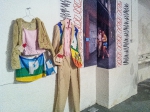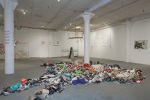SCHWARTZ GALLERY London
Patrick Michalopoulos and Ismail Erbil, Gallery Directors
Ground floor, Building 2, 92 White Post Lane London, E9 5EN, UK
www.schwartzgallery.co.uk
http://turnaroundexhibition.blogspot.com
press release
An exhibition with artists from Munich, Germany and Brisbane, Australia
turn around
LUCIA DELLEFANT· KIM DEMUTH· FRANZ EHMANN
JOACHIM FROESE· ESTHER GLÜCK· MICHAEL HOFSTETTER
PATRICIA LONDON ANTE PARIS· ANTON PETZ
OLAF PROBST· EVA RUHLAND· PAVEL ZELE©HOVSKY
Private View: Friday, 14 October 2011, 6 p.m.
with turn around happening – Patricia London Ante Paris
Friday, 14 October - Sunday, 6 November 2011
Movies night: Sunday, 6 November 2011, 6 p.m.
Opening times: Thursday - Saturday 12 a.m. – 6 p.m.
turn around - there are a variety of meanings underlying this term, and
below we try to define some of the ideas behind them: Art makes a
contribution to transforming the world or at least gives an impulse for a
possible way the world could change. Artists work with inversions of
meanings (for example, weapons looking like pieces of jewellery) to
depict aberrations. Whereas politics, religion and the economy function
one-dimensionally – each a self contained system – the artist’s view is
open-minded, comprehensive and radical in the way it thinks. Artists are
probably the only people who can induce change subversively, show
utopian ideas, ask questions, shake up or free from fixed thoughtpatterns,
because they are free in a seemingly anarchic way. That’s at
least what they should be!
Pavel Zelechovsky, Eva Ruhland, Munich, January 2011
curator: Pavel Zelechovsky, Pläntschweg 75, 81247 München, Germany
0049/(0)89/8111834, 0049/(0)172/8483255
Diese E-Mail-Adresse ist vor Spambots geschützt! Zur Anzeige muss JavaScript eingeschaltet sein!
turn around
The works of the artists for this exhibition, chosen by the artist curator Pavel Zelechovsky in
close cooperation with ten other participating artists from Munich, Germany, and Brisbane,
Australia, indicate – each in their own way – a turnaround of meanings: whether as turning
within the individual object itself, as a seduction in its reception, as an invitation to contextual
thinking and acting, or as a declaration for the impossibility of a shift in direction altogether.
Indeed, the calls for turnarounds (reversals) are already made with such abundance by
religion, economy and politics that only skepticism about announcing any reversal and about
its very announcers provides any possibility of change.
In this dialectic of stagnation and movement, conservation and change, the artists of this
exhibition perform with their own positions and draw a line from the reflection of the artists
themselves via media and social criticism all the way to a hidden iconoclasm – a critique on
the picture itself.
On the last day of the exhibition, on 6 November 2011, starting at 6 p.m., a presentation of
selected movies and videos from artists participating in the exhibition will be shown. The final
schedule will be announced later.
For Lucia Dellefant (*1965, lives in Munich, Germany), art is the inducement of social change. It
is the reward for and the gift to engaging concretely and critically in the improvement of living
standards. With her work ‘ANGST’, chosen for the exhibition, Lucia Dellefant picks out the
ambivalence of observation in public spaces. In an ironical way she exaggerates the madness
of control by governments. 26 observation cameras spy on each other. Governments are
supposed to protect people from criminal attacks – but on the other hand, people get worried
about being under full control of the authorities.
In the ‘mirrored worlds’ of Kim Demuth (*1968, lives in Brisbane, Australia), illusions meet
possible and perceived reality. Picture-events reside between apocalypse and fiction and
await immediate interpretation by the viewer to tell their real story. At the exhibition, Kim
Demuth shows two photo works – ‘Canossa 24-07-2011’ and ‘Wesley 19-06-2011’. He says that
“each image harks back to the time I spent in the hospital wards where my mother was first
diagnosed with terminal cancer and eventually returned to spend her last days. The pictures
are optically penetrating the gallery space like doorways or steps into another time and
space.”
Franz Ehmann’s (*1963, lives in Brisbane, Australia) images and installations unnerve with
ostensibly binding theories, questions and possible answers. The view turns towards mediafiltered
prophesies and promises behind which existential conditions are cruelly exposed. In
the exhibition, Ehmann presents two groups of works: ‘Wordsplinters’ and ‘POEM-BOWN
HEADLINE’. The latter is a three-dimensional poem, composed of fourteen parts – fragments of
words cut out from newspapers and hanging in different formations from the ceiling so that
their meaning and readability always stay ambiguous.
Joachim Froese (*1963, lives in Brisbane, Australia, and Berlin, Germany) exhibits two
photographic works ‘#1’ and ‘#3’ of his work group ‘Tell him it is all a transition’, in which he
processes the letters of his grandfather to his wife and two young children while on his way to
the Eastern front in World War II. Froese folded the letters to origami boats and took photos of
them. The destiny of a little girl from Hiroshima, who believes she will get well again when
folding 1000 origami cranes is a motive for this work assembly, as well as the destiny of his
grandfather who never came home again.
In her installation ‘gehalgod’ Esther Glück’s (*1966, lives in Munich, Germany) issue is the
problematic alliance of feminity, masculinity, power, authority, religion and death. These
subjects are opposing each other in a dress that is meant to seduce in a feminine way by its
luxurious fabrics, their finishing and form. The shape of individual parts of the garment, such as
cape, jacket, dress and lining remind of well–known clothes of the German Chancellor
Angela Merkel as well as of state robes of Queen Victoria and Queen Elizabeth. Turn around –
if you turn the inside out, that which seemed to be a flirtatious lingerie top under the dress is
made out of plastic bags used for the removal of corpses – of body bags.
Michael Hofstetter’s (*1961, lives in Munich, Germany) works sound out the shift between
intentional setting and public awareness. At the exhibition he shows two works: ‘didnt mean it
like that’ (2007) and ‘stain of blood’ (2008). Both works are dealing with a point of no return –
the end of individual history and the beginning of collective movement. In the movie ‘didn’t
mean it like that’ a couple strolls through Munich and then successively blows itself up as well
as the monuments of their history, by kissing each other. They seem to repeat the big world in
their small world. In the installation ‘stain of blood’, the small world is the blueprint for the big
world. Odds and ends of a single human being serve as a grid for political practice. The
imaginary is shifting into the symbolic. Books, postcards, models, sketches and the garbage of
tailors, pieces of clothes, build a field which draws a stain of blood. The same stain of blood
which a protester shows on his clothes in a newspaper picture. The idea of tabula rasa is also
present here.
Patricia London Ante Paris (*1959, lives in Munich, Germany) brings the circumstances literally
to dancing and swimming. In ‘Superfemmes’ an anarchistic playful round dance is
performed, twisting the phallic significant into nonsense and seducing the viewer to be an
active participant. The ‘Turn-Around-Happening’, shown at the exhibition, connects in its title
words from economy and art. A turn around with spending cuts and job dismissals is used in a
business concern for improving profits. A happening is an artistic activity at which the
audience participates with ambiguous denouement. ‘Turn-Around-Happening’ refers to the
hunger and excretion of global concerns with our help. Like in her other ballet pieces
‘metamat entanglement ballett’, 2009 and ‘Superfemmes’, 2010, Patricia London Ante Paris
combines criticism of our system with interdisciplinary art forms (like dance, art, music, film)
and a modernist vocabulary.
Anton Petz (*1962, lives in Munich, Germany) transforms icons of the media picture lexicon into
subjective paintings. By changing the genre he breaks up the standardized view of the
popular picture in the mass media and challenges the content in a new way. For the
exhibition ‘Turn around’, Anton Petz composed a series of large-sized paper works dealing
with the current movements of protest. As he doesn’t clarify the political context, the
potential of threatening danger or agreement remains uncertain, but he focuses our
attention on the changing social circumstances.
The title of the multi-part installation ‘globalocalacolabolg’, shown in this exhibition by Olaf
Probst (*1962, lives in Munich, Germany) is a palindrome. The main part of the installation is – in
addition to a globalocalacolabolg-chair, a globalocalacolabolg-wall shrine and a
globalocalacolabolg-airscrew – a large sketch with a GlobalocalacolabolG palindrome loop.
Olaf Probst created an almost invisible but in any case unpronouncable work with a
corporate impetus which is not – as many similar works – only actionism, welfare work,
wisacred moralism or a copy of mass media habitus – but art. And for the press, he delivers
the following text: ‘global models local, local models lacol, Lacol models labolg, labolg
models globaL. ’
In Eva Ruhland’s (*1961, lives in Munich, Germany) work, the objects and their appearance
converse into their opposite. In a certain way they act like Trojan horses, endearing
themselves esthetically to the viewer in order to mutate into prospective weapons at second
sight. The confidence into semiotic systems begins to falter. The screening of her video
“design patterns” at the exhibition shows a non-linear sequence of exposures
(video/photography) and animations. Scenes from a quite particular fashion show change
with the development of intensifying light drawings which remind the viewer of sketches and
design patterns for – in fact – weapon bags for ladies and gents, fitted for any situations and
configurations. In a seemingly alacritous way the shown fetish objects become witnesses to
anarchic contemporary acts of arbitrary assassination in which the “turn around” leads to a
never-ending futile loop of a virtual turning area.
Pavel Zele©hovsky (*1947, lives in Munich, Germany) shows his work ‘the big clearing’ <the
end of the ideologies> in two different realizations at the exhibition: Firstly as an interactive
object which engages visitors to choose their own optional ideologies. Secondly as a wall
installation displaying all possible 81 (34) variants of ideology. Zele©hovsky’s work is playing
with signifiers. Going through combinatorics of syntagmatic and paradicmatic relations, he
brings the language to its own point of non-sense and exposes all forms of propagandism and
textolatry. ‘the big clearing’ is a poem following the
mathematical principle 34. Pavel Zele©hovsky calculates within the hard basics of the global
economy. The result: 81 variants of the game for time. And nothing lacks, except for one
thing, but that constantly. To find it puts and end to ideologies and is the key to unavailable
prosperity. This is authenticity, autonomy and autarchy of the beginning which belongs to
everybody but which nevertheless is given to nobody (Quote by Wolf Dieter Enkelmann).

